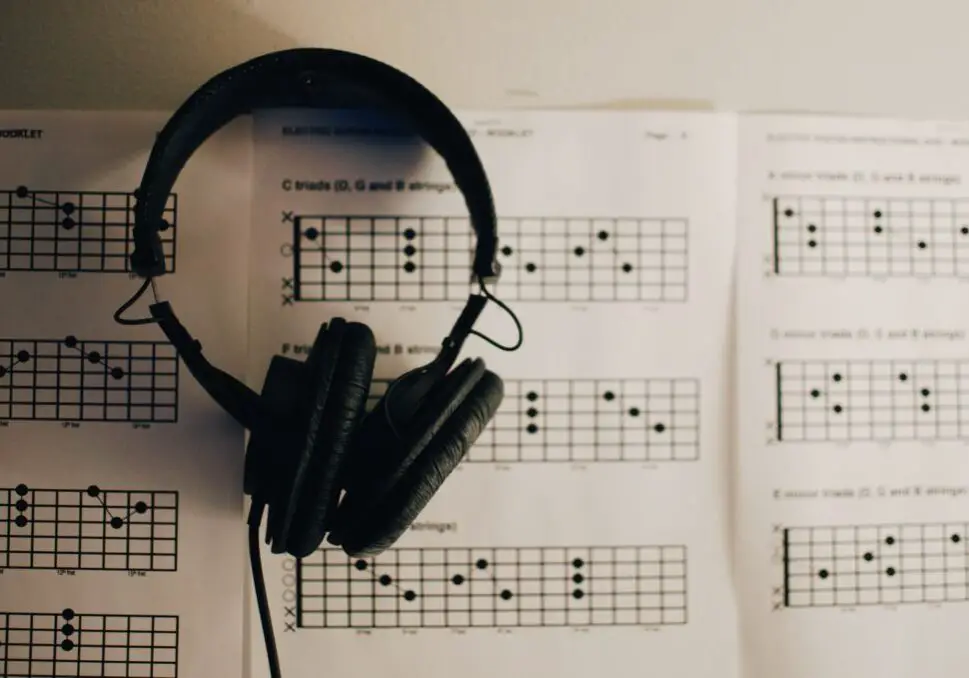It’s not hard to notice a wrong note or clunky chord when you play one (even if you’re a beginner).
What you might not know yet is why certain things sound bad.
Your challenge as a songwriter is making a song sound great without being boring or formulaic.
With every song, ask yourself:
- How do I make sure my songs start out interesting so they grab your listeners, and then stay interesting throughout?
- How do I know I’m creating the emotional impact I want?
- And finally, how can I make sure all my songs don’t sound the same?
It can be a struggle. You may be second-guessing yourself to the point where you hesitate to finish or share your songs.
But there’s good news — you don’t have to be an expert in music theory to write great songs.
In this post, you’ll learn all about how to use chord progressions in songwriting. We’ll share multiple examples to inspire and motivate you.
And you’ll also learn how to keep things fresh and add a bunch of new tools to your songwriting toolbox.
Are you ready? Let’s go!
What Are Chord Progressions?
Before we talk about chord progressions, let’s look at their building blocks — basic chords.
What is a Chord? Chord Anatomy 101
We can’t totally avoid music theory in a discussion about chords and chord progressions. But don’t sweat it if you don’t have a strong theory background. We’ll stick to the basics.
A chord is three or more musical notes (known as a triad) played together at the same time that sound good together. Which notes are used depends on the formula for the particular type of chord.
Western music is based on a seven note scale. When it comes to major scales, using the C major scale as an example, you have C, D, E, F, G, A, B, and then you’re back to C again.
Remember, major scales are based on “Do-Re-Mi…” These notes are numbered one through seven, so Do = 1, Re = 2, Mi = 3, etc.
The formula for a major chord, a.k.a. a major triad, based on the major scale is 1-3-5. So to build a major chord, you would use the first, third, and fifth notes in the scale.
For example, in the key of C, the most common form of a C major chord would be:
1 = C, 2 = E, and 3= G
So the C chord is made up of the notes C, E, and G.
Why do the notes matter?
Well, they affect why some chords sound good together and others don’t.
Because all the chords in a key use at least 3 of the 7 pitches in that scale, there are a lot of notes that overlap. That overlap is what makes these chords sound good together.
The good news is that if you stick with using chords in the same key, they will sound like they belong. But that’s not all you need.
In order for a song to make sense, sound coherent, and be memorable for your listeners, you need patterns — and many of these patterns are already proven to “work” because they’re part of hit songs.
Enter chord progressions.
Chord Progression Basics
A chord progression is a series of two or more chords that sound good together.
They are the foundation on which we build a song.
If you’re not sure where to begin as a songwriter or music composer, or if you don’t have a strong knowledge of music theory, chord progressions are the place to start.
So what role do chord progressions play in music and songwriting?
Chord progressions aren’t just blueprints for songs. They also have the power to evoke certain emotions.
As songwriters, we have to understand which chord progressions invoke which emotions and use those to our advantage when we’re writing.
That means if you want to write a sad song, you need to know what chords are going to create that emotion. Same thing when it comes to a happy song.
Typically, minor chords create greater feelings of sadness. In the same way, sexy or romantic songs often use similar vibes and chords.
If you have a basic understanding of how chords work together, including which chords evoke which emotions, you can use that to your advantage.
So before you even start writing a song, get a vision for the emotion you wish to create. Choose a progression that matches that.
That chord progression, along with its emotion, becomes your base layer for the song. Now you can feel confident that your song will have the emotional impact that you intend.
But won’t my songs sound the same as everyone else’s?
You may think that by using proven chord progressions, there will be nothing to set your songs apart from other popular songs.
But don’t worry, there are infinite variations available in all the other elements that make up a song.
1. Lyrics
The words you use obviously differentiate your songs from your competition. Compare “What’s My Age Again?” by Blink 182 to “Call Me Maybe” by Carly Rae Jepsen.
2. Melody
A different melody over the same chords changes the character of a song completely. Check out Jason Mraz’s “I’m Yours” vs. Train’s “Hey Soul Sister.”
3. Vocal Phrasing
Compare a staccato or choppy delivery, for example, “Don’t Stand So Close to Me” by the Police vs. one that’s legato (smooth and flowing), like “Can You Feel the Love Tonight?” by Elton John.
4. Genre
The same chord progression can sound quite different depending on whether it’s punk or rockabilly or Latin.
Notice how different “I Saw the Sign” by Ace of Base is compared to “If I Had A Million Dollars” by BareNaked Ladies.
5. Instrumentation/Arrangement
If you add a string section, you can get a romantic feel, horns can bring funky power, a dobro might make listeners reminisce.
Example — “Total Eclipse of the Heart” by Bonnie Tyler vs. “Teenager In Love” by Dion and the Belmonts.
5. Tempo
Is your song fast or slow, or somewhere in between? Changing up the tempo easily distinguishes your song from others using the same progressions.
Check out “Barbara Ann” by the Beach Boys and then “Good Feeling” by Flo Rida.
6. Rhythm
A memorable rhythm is an easy way to set your song apart. Try playing the same chords first using a Reggae beat, and then give them a Calypso feel.
If you had any doubts before, I hope you feel better about your songwriting possibilities and all the tools at your disposal.
A little more theory and then we can dive into the good stuff.
Scales, Keys, and Chords — And What Makes Music Sound Good

Scales and keys are the reason some musical elements sound good together and others don’t.
A scale is a series of notes that follow a distinct pattern (like Do-Re-Mi, the major scale pattern.)
A musical key is a family of notes, defined by the first note in the series, that follow one of these scale patterns.
The A major scale (following the major scale pattern) is made up of these notes: A-B-C#-D-E-F#-G#dim.
The D minor scale, as another example, is made up of D-E-F-G-A-Bb-C (it follows a different pattern, which you’ll see below.)
So how do they all fit together with chords to make music sound good?
If you go through each note in the scale, you’ll be able to create chords (triads) using those notes as the root (the lowest or the defining note) of the chord.
And because the root notes of each chord are in the same scale, the chords will sound good when you play them together. No chords in that key will sound “off” to your listeners.
How To Use Popular Common Chord Progressions
How do you find those proven chord progressions? First you gotta learn the lingo!
Progressions are named using Roman numerals that correspond to their place and their “quality” (major, minor, diminished) in the key formula.
In general, major chords use capitalized Roman numerals and minor chords use lowercase.
(Sometimes, you’ll notice people skip using lowercase, which means you’ll have to know each key signature to determine which chords will be major or minor.)
Examples will help:
- I-IV-V-I — Means you’ll play the one major, four major and five major and then return to the one or root.
- I-vi-IV-V — Means you’ll play the one major, the six minor, the four major, and finally the five major.
Major Chord Progressions
What do we mean by a major chord progression?
They are simply families of chords that fit into the major scale.
For example, if you’re in the key of C, use the root note C as the one or the root note of the scale. Next, attribute a chord value to it.
So the C (I) is a major chord. The F (IV) is also a major chord, and the G (V) is a major chord.
To continue in this chord scale, D would be a Dm or a ii minor, E would be an Em or iii minor, and the A would be an Am, a vi minor. Finally, the B is what’s called a Bb° (B flat diminished.)
You can see how it works for each key in the chart below.
Major chord progression chart
| I | ii | iii | IV | V | vi | vii⁰ |
| A | Bm | C#m | D | E | F#m | G#⁰ |
| B | C#m | D#m | E | F# | G#m | A#⁰ |
| C | Dm | Em | F | G | Am | B⁰ |
| D | Em | F#m | G | A | Bm | C#⁰ |
| E | F#m | G#m | A | B | C#m | D#⁰ |
| F | Gm | Am | Bb | C | Dm | E⁰ |
| G | Am | Bm | C | D | Em | F#⁰ |
Minor Chord Progressions
Minor chord progressions, on the other hand, are families of chords that fit into a minor scale pattern.
Minor scale chords are built exactly the same way as chords in major keys. The difference is in the key formula.
Now, your 1 is a minor chord, your 2 is a minor diminished, 3 is major, 4 and 5 are minor, and 6 and 7 are major.
Check out the chart below.
Minor chord progression chart
| i | ii⁰ | III | iv | v | VI | VII |
| Am | B⁰ | C | Dm | Em | F | G |
| Bm | C#⁰ | D | Em | F#m | G | A |
| Cm | D⁰ | Eb | Fm | Gm | Ab | Bb |
| Dm | E⁰ | F | Gm | Am | Bb | C |
| Em | F#⁰ | G | Am | Bm | C | D |
| Fm | G⁰ | Ab | Bbm | Cm | Db | Eb |
| Gm | A⁰ | Bb | Cm | Dm | Eb | F |
Popular Chord Progressions to Power Up Your Songwriting
Without further ado, here are some common chord progressions — with examples — that have been proven over and over to produce powerful, memorable, catchy songs time and time again.
Listen and use these as inspiration the next time you sit down to write.
I-V-vi-IV — The Heavy Hitter (the most popular chord progression)
- Someone Like You – Adele
- When I Come Around – Green Day
- She Will Be Loved – Maroon 5
I-vi-IV-V — Heavy Hitter, Variation 1
- Stand By Me – Ben E. King
- All the Ways – Meghan Trainor
- Unchained Melody – Righteous Brothers
I-IV-vi-V — Heavy Hitter, Variation 2
- Home – Daughtry
- Ho Hey – The Lumineers
- Temporary Home – Carrie Underwood
I-IV-V — The Big Three
- Born This Way – Lady Gaga
- You Can’t Always Get What You Want – Rolling Stones
- Funky Cold Medina – Tone Loc
I-I-I-I-IV-IV-I-I-V-IV-I-I (or V) — The 12 Bar Blues
- Johnny B. Goode – Chuck Berry
- Tush – ZZ Top
- Rock and Roll – Led Zeppelin
I-V-IV-V — Enduring
- Take On Me – A-Ha
- My Heart Will Go On – Celine Dion
- Grenade – Bruno Mars
I–V–vi–iii–IV — The Canon
- Cryin’ – Aerosmith
- Holdin’ Out for a Hero – Bonnie Tyler
- Firework – Katy Perry
ii-V-I — The Jazzy One
- Cry Me A River – Justin Timberlake
- Lie To Me – Ne-Yo
- Memories – David Guetta
vi-V-IV-V — Just a Little Dark
- In the End – Linkin Park
- Sultans of Swing – Dire Straits
- Somebody That I Used To Know – Gotye
Tips for Successful Songwriting with Chord Progressions

Let’s wrap up with some of my best advice.
1. Understand the genre you’re writing for.
Listen to other songs in your genre and use some of the same progressions.
If you’re trying to write a country song, listen to country music. (It depends on whether you’re writing for radio, for other artists, or for yourself, for example.)
I’m not encouraging you to steal, but everybody uses the same chord progressions and slight variations of them.
So start with the songs you love and the artists you love. Figure out what chords they’re using and try to emulate some of those emotions.
2. Use a four chord progression as a starting point.
If you’re stuck, find a four chord progression. For example, in the key of G, you’d use G, C, E minor, and D — that would be the 1-4-6m-5 using Nashville numbers.
Use that four chord progression for the verse, change to a different chord in the pre-chorus (like a 2 minor, or even just the 5 chord), and then return to that same progression for the chorus.
Repeat that progression in the next verse. That’s a good basic layer.
3. Keep it simple.
Don’t over-complicate the progression just for the sake of adding more chords. That’s one reason it’s so important to have an understanding of which chords work well for the genre you’re writing in.
You can easily make a song sound out of genre by using certain chords. So keep it simple. Use chords to your advantage, not to your disadvantage.
There are plenty of songs that use only two or three chords. That’s a good place to start if you’re a beginner (say with a 1-4-5 progression).
It’s also a nice exercise to come back to if you’re more experienced and want to give yourself a challenge.
Write Better Songs With Proven Chord Progressions
Whew! We’ve covered a lot in this post. Congrats for sticking with me to the end.
You know now that you can write great songs — even if you don’t have a strong background in music theory.
You’ve learned why some chords and melodies work while others don’t.
You’ve learned about the power of emotion in songwriting and how to tap into that with the right chord progressions.
Hopefully you’re feeling a lot more confident and inspired when it comes to your own songwriting.
My final advice: don’t be afraid to experiment.
Use these progressions as a starting point, but don’t stop there.
Theory explains why some of our experiments work and others don’t — in the end, trust your ears and your natural creativity.
And if you’d like to dive deeper, check out How to Write a Song.
Happy songwriting!


